Acer Aspire V3-571G-9435: The Value Proposition
by Jarred Walton on July 4, 2012 4:25 AM ESTAcer V3-571G General Performance
We start as usual with our general performance application benchmarks. We still don’t have quite as many laptops available in our updated Mobile Benchmark Suite as we’d like, and there’s not much point in comparing a full-size notebook with several different models of Ultrabook. We’ve tried to stick with the more meaningful comparisons where possible, but we also wanted to flesh out the charts with additional data points. The result is the following selection of laptops, with their basic specs listed in the table, and as always, should you want to make additional comparisons, head over to Mobile Bench.
| Laptop Configuration Overview | ||||
| Laptop | CPU | Graphics | Storage | Battery |
| Acer Aspire V3-571G | Intel i7-3610QM | GT640M/HD4000 | HDD | 48Wh |
| Acer TimelineU M3 | Intel i7-2637M | GT640M/HD3000 | SSD | 55Wh |
| AMD Trinity Prototype | AMD A10-4600M | HD7660G | SSD | 56Wh |
| ASUS N56VM (Prerelease) | Intel i7-3720QM | GT630M/HD4000 | HDD | 56Wh |
| ASUS Zenbook Prime UX21A | Intel i7-3517U | HD4000 | SSD | 35Wh |
| ASUS G74SX-A2 | Intel i7-2630QM | GTX560M/HD3000 | SSD | 90Wh |
| Clevo W110ER | Intel i7-3720QM | GT650M/HD4000 | Hybrid | 62Wh |
| Razer Blade | Intel i7-2640M | GT555M/HD3000 | SSD | 60Wh |
| Sony VAIO SE | Intel i7-2640M | HD6630M/HD3000 | HDD | 49Wh |
| Toshiba P755D | AMD A8-3520M | HD6620G | HDD | 47Wh |
As we’re starting with PCMark results, we again want to note how much of an impact the presence of an SSD has on the results. It makes most of the comparisons between the HDD and SSD equipped laptops meaningless, but it does serve to drive home the point that for some workloads an SSD will make a huge difference. I switched over to a 240GB SSD for my laptop and Ultrabook use, and whenever I have to use and test a laptop that only has HDD storage (like the Acer V3), the difference is painfully obvious.
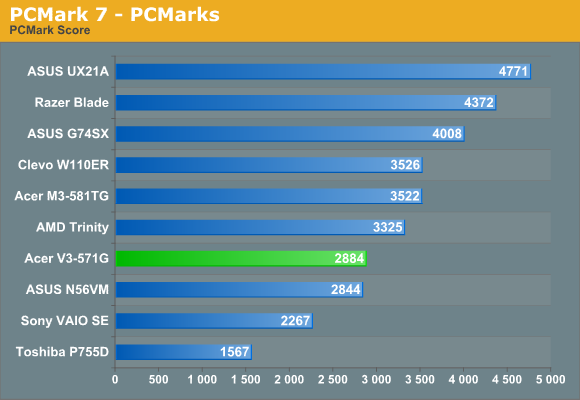
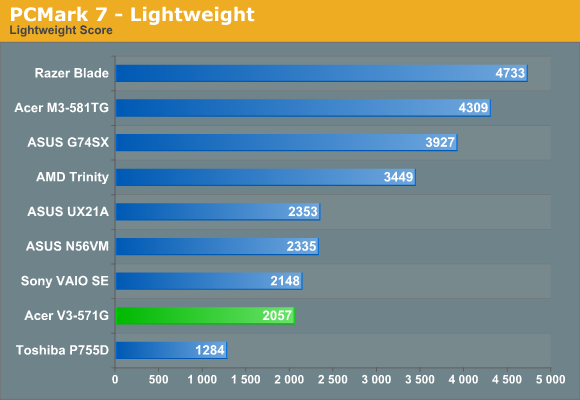
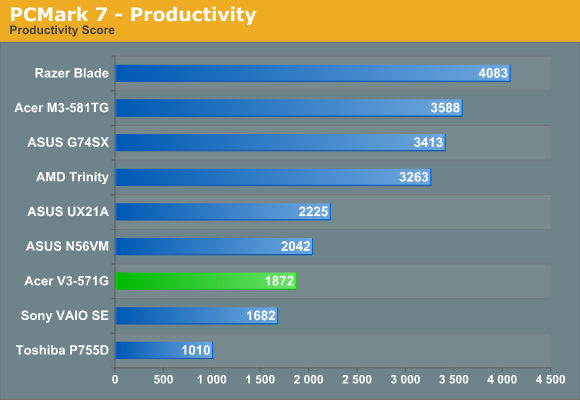
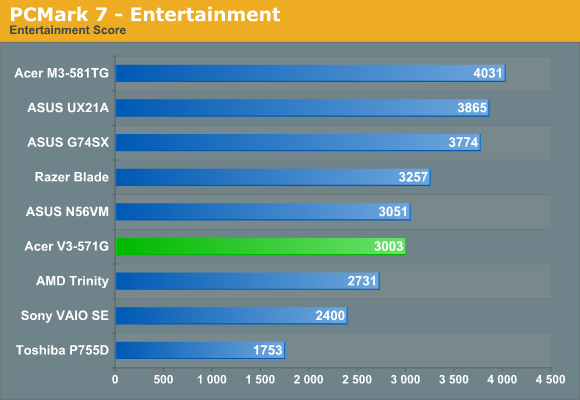
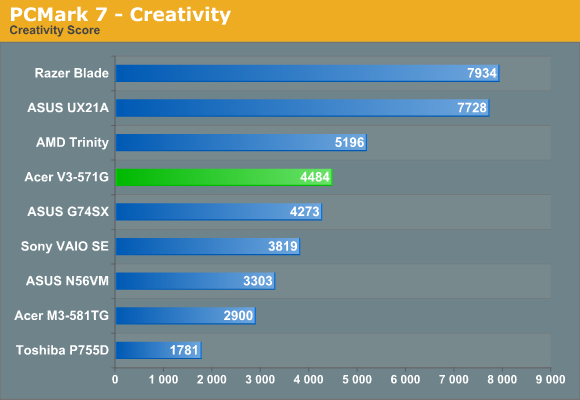
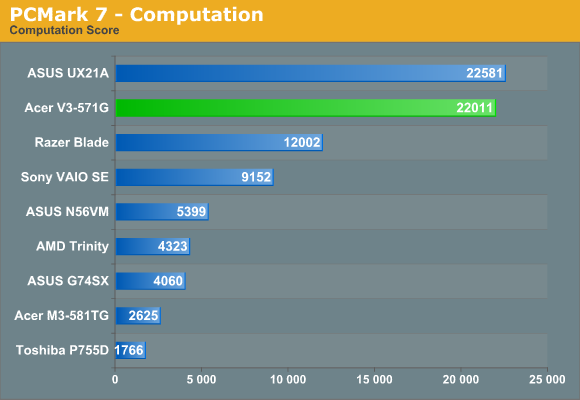
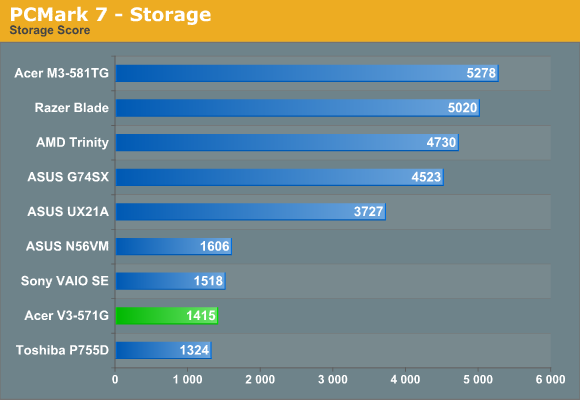
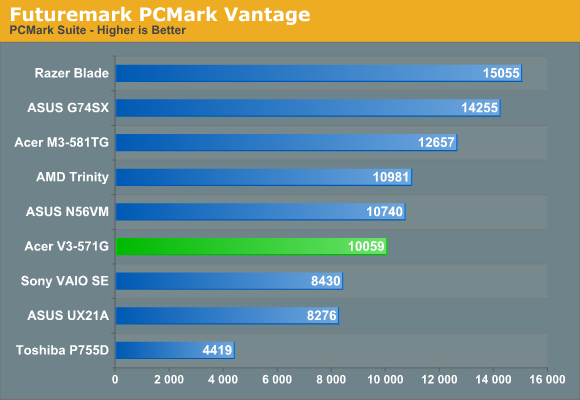
The placement of the Acer V3 in the above charts isn’t very inspiring, but remember what we said about SSDs. Most of the higher scoring laptops feature SSDs and/or slightly faster CPUs. For general use, any of the laptops will be “fast enough”, and as long as you don’t mind waiting during intense periods of disk activity (e.g. initial boot up of the OS and various applications) even the HDD equipped laptops will work well. Still, one look at what an SSD does for the ASUS N56VM might make you consider splurging on better storage system. Acer adds insult to injury here by going with a 5400RPM hard drive, and the only slower Storage score in the charts comes from the Toshiba P755D—which also uses a 5400RPM Toshiba hard drive, not surprisingly.
If we look at the one PCMark 7 test that doesn’t hit storage at all, the Computation suite, we run into a different problem. Here, all of the laptops that support Intel’s Quick Sync technology get a massive performance boost, and the Ivy Bridge processors are basically twice as fast with Quick Sync as Sandy Bridge parts. It makes for yet another lopsided graph, which makes the overall usefulness of the PCMark scores debatable. As long as we understand what the charts represent, however, we can at least use them to gauge relative performance. The basic summary is that, for general use, a moderate CPU (e.g. Trinity, Llano, or Sandy Bridge) with an SSD will offer a better experience than just about any current HDD-based laptop; similarly, if you want to do hardware accelerated video encoding, there’s no beating Quick Sync.

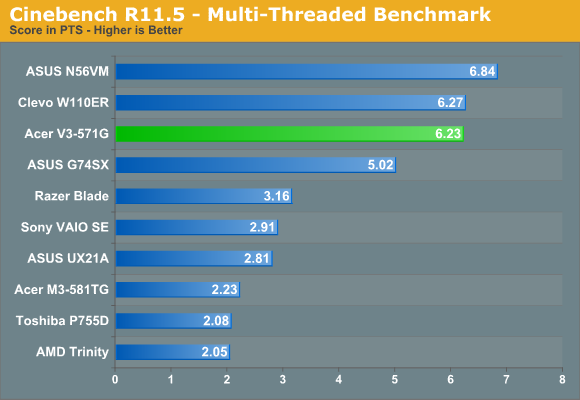
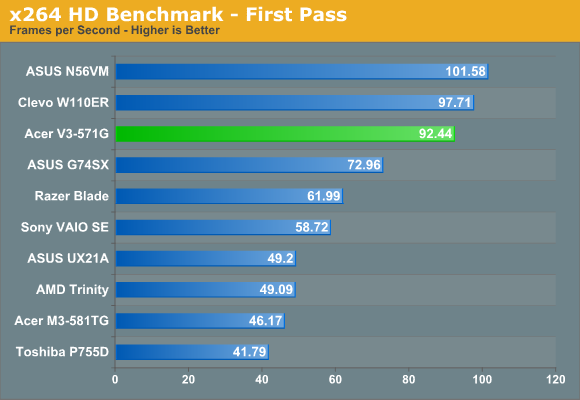
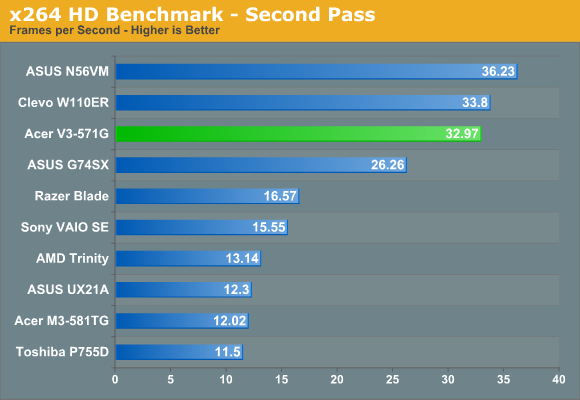
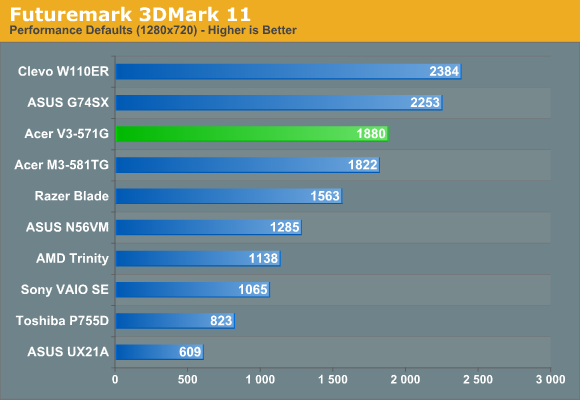
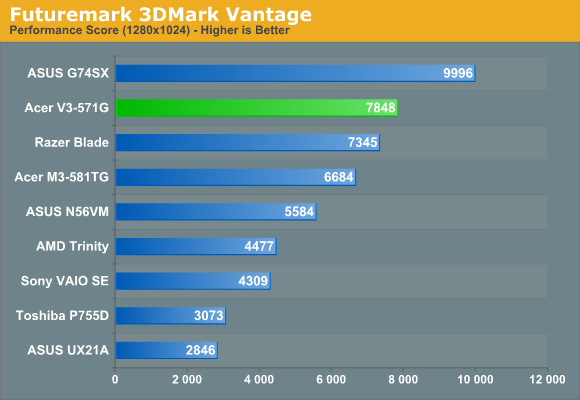
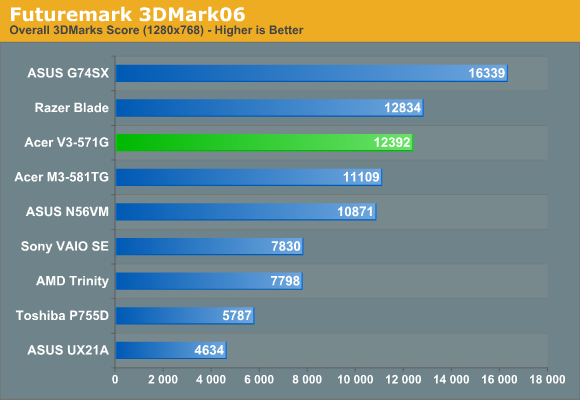
When we shift over to our more CPU- and GPU-centric tests, the performance results start to look more sensible. As one of two quad-core Ivy Bridge laptops, the Acer V3-571G takes second place in all four of our CPU-based tests, losing out by a small margin to the higher clocked i7-3720QM in the ASUS N56VM. The 3DMark scores tell a similar story, although this time it’s the GTX 560M in the ASUS G74SX that takes first place, with the GT 640M generally falling into second place and trading blows with the Razer Blade and Acer M3-581TG Ultrabook. The latter has the same GPU but a slower ULV Sandy Bridge processor, and we should hopefully have the updated M5 Ivy Bridge model in for testing in the near future.










88 Comments
View All Comments
JarredWalton - Saturday, July 7, 2012 - link
It's not an "assumption" that chiclet is better, but I can't think of one thing about the old style "floating island" keyboard that is better to this new "floating chiclet". That's not to say that this keyboard is perfect, but as I note in the review, I did a fair amount of typing on the V3 and the keyboard is certainly usable without severe complaints by me -- someone that writes 5000 word articles for a living. Is it equal to some of the older ThinkPad keyboards? Not really, but I'm not sure ThinkPad has ever done a perfect keyboard layout with a 10-key either, outside of the W700 line. For a 15.6" keyboard with a 10-key, the layout is just about perfect, even if the key action could be improved.pullmyfoot - Saturday, July 7, 2012 - link
You guys should do a review of the Samsung Chronos 7 700Z5C. I just got one and its the perfect laptop IMO without breaking the bank.70% aluminum construction
A above average screen at 1600x900
1TB 7200RPM with 8GB SSD express cache
Rest of the specs are the same if not slightly better than this Acer.
apmon2 - Saturday, July 7, 2012 - link
Given that so many Laptops still seem to be sold with crappy screens and that good replacement screens can be got for less than $100, it would be great if AnandTech could write more about this.If you could write a separate article on how to switch laptop screens and what you need to consider, as well as review the different available after market LCD screens, perhaps more people would choose to switch their screens and not suffer from their crappy display.
This could even benefit those buying high-end laptops, if it becomes common to order the laptop with the cheapest display and then replace it with a high quality on later on, just as it is common to order the cheapest HDD and then replace it with an SSD.
E.g. Lenovo charge $250 for the full HD screen upgrade on the Thinkpad T530, whereas the screen costs less than $100 if bought separably. One also then has a better choice, be it matt vs glossy, IPS vs TN, high colour gamut or not, rather than the one choice offered by the manufacturer.
jabber - Saturday, July 7, 2012 - link
I'd like to see an article on what the costs are to the manufacturer for screens.Basically what does a standard 15" TN glossy 1366x768 screen cost compared to -
15" TN 1600x900 (glossy/non glossy)
15" TN 1920x1080 (glossy/non glossy)
15" IPS 1600x900
15" IPS 1920x1080
I havent included 16:10 as I don't wish to hope for too much.
JarredWalton - Saturday, July 7, 2012 - link
The manufacturers don't disclose their costs for individual components, so it's impossible to say what they pay. I've had one manufacturer insist that what we pay for an LCD on, e.g. LaptopScreens.com, is less than they would pay. That seems unlikely to me (if you're ordering 10,000 LCDs, you're not going to pay more than if you're ordering 1 screen, are you?) but they do note that there's also difficulty at times in procuring the required number of displays. My hunch is that LaptopScreens probably marks up the LCDs they sell by 10% over what they pay, and large manufacturers pay a bit less than them. But I could be wrong.chromatix - Saturday, July 7, 2012 - link
I have a 14" display from *1994* that can manage 115 dpi without much trouble. Bear in mind that 14" is the tube diagonal, not the display area, and that this is a fairly bog-standard "fishbowl" monitor. Driving it at 1152x870 results in the aforementioned 115dpi.Coincidentally, this is also approximately the density of both of my much newer flatscreen monitors, which are of course meant for viewing at a greater distance than a laptop. It is also the density of the roughly 2000-vintage ThinkPad that I rescued from the office scrap pile recently - with 1400x1050, the screen is excellently configured for coding, even if the viewing angles and colour reproduction are awful by modern standards. (It's very useful to have lots of *lines* of code on screen at once.)
My 2006 17" MBP pushes the density up to 130 dpi with 1920x1200. I have to go back to my 2000-vintage PowerBook G3 to get down to 100 dpi.
Meanwhile, a 15.6" laptop display with less than 1400 pixels across is going to be 100 dpi maximum. At laptop viewing distances, that's like putting standard definition up on a 50" TV - you can see the pixels without even trying. Antialiasing is a wonderful thing, but it has limits to what it can hide. On an old PowerBook it was forgivable because it was the best thing available (and the panel was decent) - but today, and with contrast numbers that make flip-up sunglasses look good...
Surely someone out there knows how to make a laptop with good build quality, good ergonomics, a big battery and a good screen, and doesn't mind reducing the performance a bit to suit the price? I don't even care if it's two inches thick, as long as the screen and the body aren't shiny - I would prefer to see my code and my game rather than my own ugly mug.
That's another point - thinness is vastly overrated. Comparing my PowerBook G3 to my MBP, they are the same depth, the MBP is 21% wider (15.4" vs 12.7") and the G3 is 70% thicker (0.98" vs. 1.7"). They're not much different in weight - the G3 is 2.8kg, the MBP is 3.1kg. But it's the MBP that feels "bigger". It also feels considerably more fragile to pick up - I feel the need to grab it by both sides, rather than levering it up by one side, even though intellectually I realise it's probably strong enough to withstand such treatment, and my other hand might be otherwise occupied.
Meanwhile, I still have a lot more difficulty putting both the MBP and my 15" AlBook - a total of 2.1" thickness - in the same bag, than I do just putting the G3 in. Part of that is, I think, because the G3 is more rounded at the edges, so it doesn't catch on things so easily. Little details like that - and thermal performance - matter a lot more than being thin. It's even worse when important functionality (such as recording dual-layer DVDs, or being able to replace the battery, RAM and hard disk without risking ruining the whole machine) are sacrificed in the name of the holy measurement.
Iketh - Sunday, July 8, 2012 - link
YEA SILVA!!!!!QuantumPion - Monday, July 9, 2012 - link
I got an Acer laptop last year with sandy bridge core i5 and nvidia GT 540M for $450 after instant rebate. The display sucks but $450 for a laptop fully capable of playing Skyrim and Battlefield 3 is hard to beat.DotNetGuru - Monday, July 9, 2012 - link
Just wanted to drop a comment to show my appreciation for this great review.Very well done. Thanks!!
rudolphna - Monday, July 9, 2012 - link
I actually just picked up the Trinity A8-4500M version of this laptop for $529 on newegg, and I have to say, though the screen isn't that great, overall it's a great deal for the price. I'm certainly not going to complain about the amount of horsepower I managed to get for $530. I also did order a Momentus XT 500GB, and 8GB of Corsair DDR3-1600 that should arrive tomorrow to hep up the performance a bit more. Once that's done, I doubt there are any other laptops on the market with this kind of value.